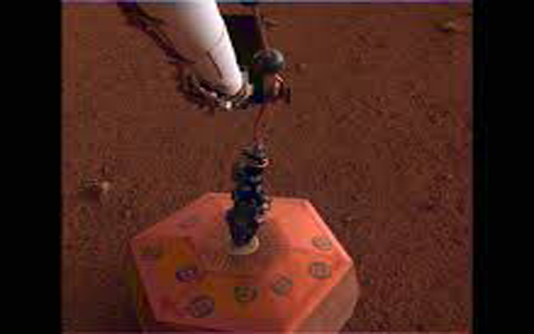LOS ANGELES, Dec. 21, 2018 (BSS/XINHUA) – NASA’s InSight lander has
deployed its first instrument onto the surface of Mars, marking the first
time a seismometer had ever been placed onto the surface of another planet.
New images from the lander showed the seismometer on the ground, its
copper-colored covering faintly illuminated in the Martian dusk, according to
the InSight team on Thursday.
“InSight’s timetable of activities on Mars has gone better than we hoped,”
said InSight Project Manager Tom Hoffman, who is based at NASA’s Jet
Propulsion Laboratory in Pasadena, California.
“Getting the seismometer safely on the ground is an awesome Christmas
present,” he said.
The InSight team has been working carefully toward deploying its two
dedicated science instruments onto Martian soil since landing on Mars on Nov.
26. Besides the seismometer, also known as the Seismic Experiment for
Interior Structure (SEIS), the other one is the heat probe, known as the Heat
Flow and Physical Properties Probe (HP3).
Meanwhile, the Rotation and Interior Structure Experiment (RISE), which
does not have its own separate instrument, has already begun using InSight’s
radio connection with Earth to collect preliminary data on the planet’s core,
said the InSight team.
To ensure the successful deployment of the instruments, engineers had to
verify the robotic arm that picks up and places InSight’s instruments onto
the Martian surface was working properly.
They also had to analyze images of the Martian terrain around the lander to
figure out the best places to deploy the instruments, said the team.
InSight engineers sent up the commands to the spacecraft on Tuesday, and
the seismometer was gently placed onto the ground by the arm in front of the
lander on Wednesday, according to the team.
“Seismometer deployment is as important as landing InSight on Mars,” said
InSight Principal Investigator Bruce Banerdt.
“The seismometer is the highest-priority instrument on InSight. We need it
in order to complete about three-quarters of our science objectives,” he
said.
The seismometer allows scientists to peer into the Martian interior by
studying ground motion, also known as marsquakes. By analyzing how seismic
waves pass through the layers of the planet, scientists can deduce the depth
and composition of these layers.
In the coming days, the InSight team will work on leveling the seismometer.
The first seismometer science data will flow back to Earth after the
seismometer is in the right position, said the team.
The heat probe is scheduled to be placed onto the Martian surface by late
January, on the east side of the lander’s work space, according to the team.
InSight landed safely on Mars on Nov. 26, kicking off a two-year mission to
explore the deep interior of the Red Planet.



